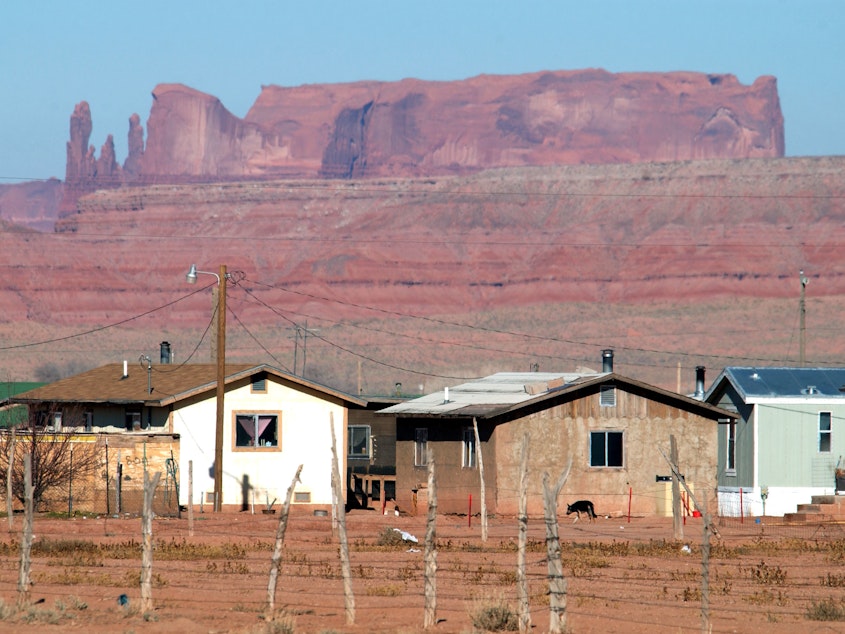Native Americans On Tribal Land Are 'The Least Connected' To High-Speed Internet

Just over half of Native Americans living on American Indian reservations or other tribal lands with a computer have access to high-speed internet service, according to new estimates from the U.S. Census Bureau.
The low rate of subscription to a high-speed internet service — 53 percent — in these often rugged, rural areas underscores the depth of the digital divide between Indian Country and the rest of the U.S. Between 2013 and 2017, 82 percent of households nationally with a computer reported having a subscription to a broadband internet service.
The latest data from the bureau's American Community Survey also show a stark national gap in high-speed internet subscription rates between Native Americans generally (67 percent) and those who do not identify as American Indian or Alaska Native (82 percent).
These numbers are among the most comprehensive estimates of internet use the federal government has produced. In 2013, the American Community Survey began asking people if and how they access the internet. On Thursday, the Census Bureau released the first-ever estimates of internet subscription rates for all of counties in the U.S. To calculate the rates, the bureau included responses from households with high-speed service through their home, mobile or satellite internet service.
"The least connected"
Sponsored
The findings are no surprise to Traci Morris. She leads the American Indian Policy Institute at Arizona State University, which is preparing to release a report on a new study of broadband internet service on tribal lands.
"We're the least connected. We're under-connected. We're under-served," says Morris, a member of the Chickasaw Nation of Oklahoma.
Mobile phones often are the main tools to help residents on American Indian land to get online, but many communities do not have reliable cell coverage nearby. On some reservations, Morris adds, residents rely on internet service at the local library, tribal office or school.
"Folks find a way to access it. Folks are resilient," she says. "But it shouldn't be this way in the U.S. We should have the same access as other folks, and if we don't, it's going to put us down a path of further have's and have not's."
A major obstacle to high-speed internet access on tribal land is the lack of infrastructure. Morris says it's been a hard sell to convince service providers to erect cell towers or bury fiber-optic cables in sparsely populated communities.
Sponsored
"There's no bang for the buck to go where one house is when you can go somewhere where there's a hundred houses you could service," she says.
A need for "the right data"
Federal funding is available to encourage internet service providers to invest in rural and remote areas of the country. But between 2010 and 2017, less than one percent of such federal funding from the Federal Communications Commission and the Department of Agriculture's Rural Utilities Service has been awarded directly to tribes or service providers owned by tribes, according to a recent Government Accountability Office report.
"Representatives from eight of the tribes we contacted told us that in general, the language included in the federal grant applications is difficult to understand or the administrative requirements of federal grants are burdensome," the GAO researchers wrote in their report released in September.
Another recent GAO report found that FCC reports and maps overstate the availability of broadband internet service on tribal lands. If a service provider reports — using something called Form 477 — that it could provide broadband internet access to at least one location in a neighborhood, the FCC considers broadband to be "available" in that neighborhood. The problem, the GAO found, is that the "available" status is applied too broadly, sometimes including communities without any infrastructure that connects homes to a service provider's network.
Sponsored
"A few providers told us that the lack of clear guidance from FCC regarding how to determine where broadband is available has led different providers to interpret the Form 477 directions in different ways, which can affect the accuracy and consistency of reporting from provider to provider," the GAO researchers wrote.
That inaccurate data have prevented some tribes from receiving federal funds.
Geoff Blackwell, a former chief of the FCC's Office of Native Affairs and Policy, testified at a Senate hearing in October on the GAO reports. He says the new Census Bureau estimates of internet use may help fact-check the FCC's broadband data and, ultimately, lead to a shrinking of the digital divide.
"I hope the true obstacles of Indian Country will be revealed by new data so that government and industry can look at new models, new approaches and new incentives," says Blackwell, who now serves as the chief strategy officer and general counsel of AMERIND Risk Management Corporation.
"It really does start with having the right data," he adds. [Copyright 2018 NPR]


